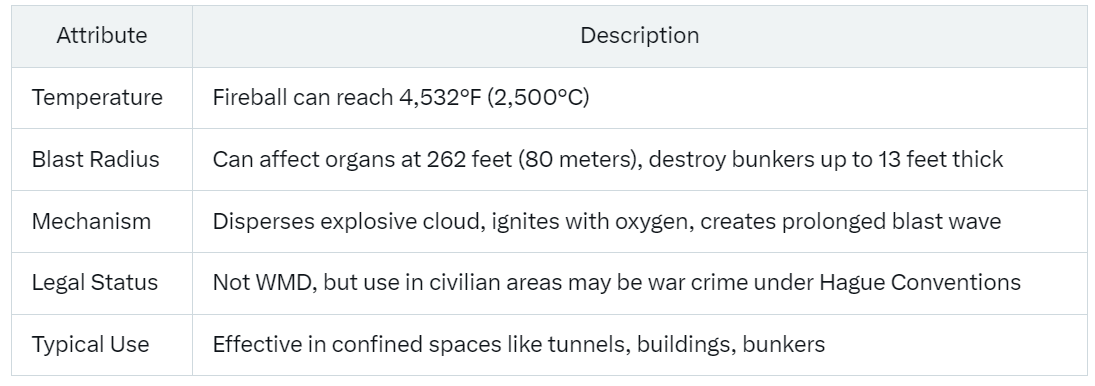Fire and Steel
Comprehensive Analysis of China's Thermobaric Robots for Urban Warfare
This post provides a examination of China's exploration of equipping robot dogs with thermobaric weapons for urban warfare supremacy, as reported in recent news from February 2025. The analysis covers the nature of thermobaric weapons, the context of the proposal, its implications, and the current state of development, aiming to offer a thorough understanding for readers interested in military technology and its ethical dimensions. I used Grok’s new DeepSearch for this one.
Understanding Thermobaric Weapons
Thermobaric weapons, also known as vacuum bombs or fuel-air explosives, operate by dispersing a fine cloud of explosive material, such as powdered metals (e.g., aluminum, magnesium, titanium, zirconium) or non-metals like boron-silicon, and then igniting it. This process consumes oxygen from the surrounding air, creating a high-temperature explosion with a fireball reaching up to 4,532°F (2,500°C). The resulting blast wave is prolonged, causing significant overpressure that can destroy organs even at 262 feet (80 meters) away and break down bunkers up to 13 feet thick. Their effectiveness in confined spaces, such as tunnels and buildings, stems from the vacuum effect, which can suffocate occupants by depleting oxygen.
While not classified as weapons of mass destruction under international law (which typically includes nuclear, chemical, and biological weapons), thermobaric weapons are often described as second only to nuclear arms in lethality due to their destructive potential.
Context of Urban Warfare and Robot Dogs
Urban warfare presents unique challenges, including GPS jamming, electromagnetic interference, and the complexity of navigating dense, built-up areas. Robot dogs, such as those from Deep Robotics (e.g., the X30 model), have been increasingly integrated into military operations for reconnaissance and combat support. Previous demonstrations, such as China's joint drills with Cambodia in 2024, showed robot dogs equipped with rifles, indicating a trend toward weaponizing these platforms. The proposal to arm them with thermobaric weapons aims to address limitations faced by light weaponry in flushing out enemies from fortified structures or underground bunkers, as identified in recent PLA urban warfare drills.
The study, led by Dang Chenguang and published in the Journal of Ordnance Equipment Engineering, suggests a coordinated approach where aerial drones act as "eyes and commanders" for reconnaissance, while robot dogs serve as "armored beasts" to execute strikes with thermobaric charges. This strategy is intended to achieve "comprehensive annihilation," particularly in scenarios where traditional weapons are neutralized by urban interference.
Detailed Proposal and Testing
The proposal involves equipping quadrupedal unmanned ground vehicles (Q-UGVs), likened to robotic dogs, with thermobaric warheads. Tests in mock urban battlefields have evaluated parameters such as situational awareness, command control, and coordinated strikes, ranking teams based on performance. The focus is on using these systems to pursue enemies in urban settings where camouflage and hiding options are abundant, such as underground complexes. The study emphasizes that subsequent attacks would be assessed for injury levels to targets, suggesting some level of control, though the destructive nature of thermobaric weapons complicates precision.
This development builds on prior military applications of robot dogs, seen with guns and flamethrowers in China and other nations, but thermobaric weapons represent a significant escalation due to their potential for mass destruction.
Ethical and Legal Implications
The use of thermobaric weapons in urban areas raises serious ethical and legal concerns. The International Review of the Red Cross notes that their deployment in civilian-populated areas could constitute a war crime under the Hague Conventions of 1899 and 1907, particularly if targeting schools, hospitals, or other protected sites. Their indiscriminate nature, capable of vaporizing human bodies and causing widespread collateral damage, poses a high risk to non-combatants, as seen in allegations against Russia’s use in Ukraine. The proposal’s focus on "comprehensive annihilation" further amplifies fears of disproportionate harm, potentially violating principles of distinction and proportionality in international humanitarian law.
Moreover, the integration of such weapons into autonomous or remotely operated systems like robot dogs raises questions about human control over lethal force, a growing concern in the debate over autonomous weapons.
Current Status and International Reaction
As of March 1, 2025, the evidence leans toward this being an experimental proposal, with no confirmed reports of active deployment. The study and drills suggest ongoing research, but official statements from China are limited, with no specific responses from the PLA or government directly addressing this development. International reactions are not extensively documented in recent reports, though given the controversy, it is likely to draw attention from global bodies and military analysts, especially in light of past debates over thermobaric weapons’ use in conflicts.
Comparative Analysis and Broader Trends
This development fits into a global trend of militarizing robotic systems, with the United States, Russia, and others also exploring similar technologies. For instance, the U.S. has tested robotic systems for base security, and Russia has deployed thermobaric weapons in Ukraine, drawing criticism. China’s approach, however, is notable for combining advanced robotics with highly destructive munitions, potentially setting a precedent for future urban warfare tactics. This escalation could lead to an arms race in autonomous weapon systems, raising questions about regulation and the future of warfare.
Table: Key Attributes of Thermobaric Weapons
Conclusion
China’s exploration of thermobaric weapon-wielding robot dogs for urban warfare reflects a strategic response to modern combat challenges, leveraging advanced robotics for enhanced lethality. However, the proposal’s implications, particularly regarding civilian harm and legal compliance, underscore the need for careful consideration and international dialogue. As of March 2025, this remains a research and testing phase, with significant ethical and legal hurdles to overcome before potential deployment.
Key Citations



